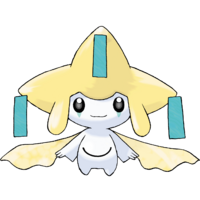On the Origin of Species: Jirachi
|
Here in the West, the concept of wishing on a star can be traced back at least as far as Roman times. But it's a more universal concept than many people realize. Today, on the seventh day of the seventh month, Japan celebrates Tanabata, the star festival. And so, it seemed like a good opportunity to take a look at Jirachi, a Pokémon heavily inspired by the festival.
The story of Tanabata itself, like many Japanese legends, has its origins in China, with a tale called The Princess and the Cowherd. There are many versions of this story, but the version most commonly known in Japan is as follows...
Orihime (織姫) was the daughter of the King of Heaven. She lived in the sky, where she would weave cloth for her father on the banks of the Milky Way, or Amanogawa (天の川), literally meaning the River of Heaven. The princess worked so hard that she became lonely, and so her father introduced her to a cowherd named Hikoboshi (彦星) from the other side of the river. The pair fell in love at first sight, and they soon married. Once married, however, the couple spent so much time together that they ceased to do any work. Orihime's cloth remained unwoven, and Hikoboshi's cows were left to wander across the heavens. After a while, the King of Heaven grew angry, and used the Milky Way to separate the lovers, placing them on opposite sides and forbidding them to cross. Orihime was devastated, and his daughter's tears eventually moved the King of Heaven to offer a compromise: the couple would be allowed to meet for one night a year, on the seventh day of the seventh month.
If the weather was bad and the river flooded, however, the couple would be unable to cross it, and would have to wait another year to meet. So both of them would pray for good weather, and if they were able to meet, anyone who made a wish on that day would also have their wish granted. Orihime and Hikoboshi are represented in the night sky by Vega and Altair, two bright stars that are highest in the sky during late summer. It's said that if the sky is clear, the stars will shine with many different colors, showing that Orihime and Hikoboshi have met successfully.
China's equivalent of Tanabata is called Qixi, or 'the night of sevens'. It is held on the seventh day of the seventh month of the Chinese lunisolar calendar, which this year falls upon August the 16th. In Japan, the date has since been adapted to fit the Gregorian calendar, thus making it the July the 7th. However, some festivals are still held according to the Chinese calendar, and others – including the most famous, held in Sendai – are scheduled around the 7th of August.
During Tanabata, shopping streets will be decorated with colorful streamers, and many cities hold parades. But the focal point of the festival is wishing. Wishes are written on strips of paper called tanzaku, and hung from bamboo branches. At midnight or on the following day, these may be burned. Tanabata also has a song associated with it, which goes as follows:
Sasa no ha sara-sara (笹の葉さらさら)
Nokiba ni yureru (軒端にゆれる)
Ohoshi-sama kira-kira (お星様キラキラ)
Kin gin sunago (金銀砂子)
Translated, this means:
The bamboo leaves rustle, rustle,
Shaking away in the eaves.
The stars go twinkle, twinkle,
Gold and silver grains of sand.
Jirachi itself is a mixture of diverse influences, though all of them relate to wishes. Its star shape references both Tanabata and the Western traditions of wishing on a star, while its name has many potential origins. The most likely combination may well be the Russian word zhelatʹ (желать), meaning 'to wish', and the Japanese sachi (幸), which means 'fortune' or 'luck'... but I wonder if 'djinn' or 'genie' might also have influenced the name.
Probably Tanabata's biggest influence on Jirachi's design is the tanzaku that can be seen hanging from its head. The Pokédex itself states that "A legend states that Jirachi will make true any wish that is written on the notes attached to head when it awakens." Jirachi is also said to wake up for just seven days every thousand years, which may well be a reference to Tanabata's association with the number seven. Another entry states that Jirachi will awaken if sung to with a pure voice, which brings to mind the Tanabata song.
As an event Pokémon, Jirachi has traditionally been made available in Japan on or around Tanabata, although during this year's festival, the tradition has been extended to the rest of the world. So, on that international note, perhaps we should all take the opportunity to make a wish, and hope for good weather for Orihime and Hikoboshi's meeting. A very happy Tanabata to you all!

